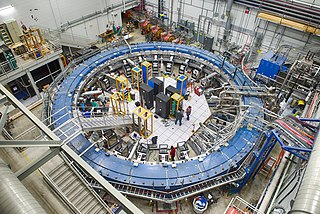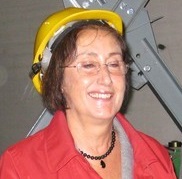Related Research Articles

Particle physics or high energy physics is the study of fundamental particles and forces that constitute matter and radiation. The fundamental particles in the universe are classified in the Standard Model as fermions and bosons. There are three generations of fermions, although ordinary matter is made only from the first fermion generation. The first generation consists of up and down quarks which form protons and neutrons, and electrons and electron neutrinos. The three fundamental interactions known to be mediated by bosons are electromagnetism, the weak interaction, and the strong interaction.

The Standard Model of particle physics is the theory describing three of the four known fundamental forces in the universe and classifying all known elementary particles. It was developed in stages throughout the latter half of the 20th century, through the work of many scientists worldwide, with the current formulation being finalized in the mid-1970s upon experimental confirmation of the existence of quarks. Since then, proof of the top quark (1995), the tau neutrino (2000), and the Higgs boson (2012) have added further credence to the Standard Model. In addition, the Standard Model has predicted various properties of weak neutral currents and the W and Z bosons with great accuracy.
The tau, also called the tau lepton, tau particle, tauon or tau electron, is an elementary particle similar to the electron, with negative electric charge and a spin of 1/2. Like the electron, the muon, and the three neutrinos, the tau is a lepton, and like all elementary particles with half-integer spin, the tau has a corresponding antiparticle of opposite charge but equal mass and spin. In the tau's case, this is the "antitau". Tau particles are denoted by the symbol
τ−
and the antitaus by
τ+
.
In particle physics, the W and Z bosons are vector bosons that are together known as the weak bosons or more generally as the intermediate vector bosons. These elementary particles mediate the weak interaction; the respective symbols are
W+
,
W−
, and
Z0
. The
W±
bosons have either a positive or negative electric charge of 1 elementary charge and are each other's antiparticles. The
Z0
boson is electrically neutral and is its own antiparticle. The three particles each have a spin of 1. The
W±
bosons have a magnetic moment, but the
Z0
has none. All three of these particles are very short-lived, with a half-life of about 3×10−25 s. Their experimental discovery was pivotal in establishing what is now called the Standard Model of particle physics.

Gargamelle was a heavy liquid bubble chamber detector in operation at CERN between 1970 and 1979. It was designed to detect neutrinos and antineutrinos, which were produced with a beam from the Proton Synchrotron (PS) between 1970 and 1976, before the detector was moved to the Super Proton Synchrotron (SPS). In 1979 an irreparable crack was discovered in the bubble chamber, and the detector was decommissioned. It is currently part of the "Microcosm" exhibition at CERN, open to the public.

Jack Steinberger was a German-born American physicist noted for his work with neutrinos, the subatomic particles considered to be elementary constituents of matter. He was a recipient of the 1988 Nobel Prize in Physics, along with Leon M. Lederman and Melvin Schwartz, for the discovery of the muon neutrino. Through his career as an experimental particle physicist, he held positions at the University of California, Berkeley, Columbia University (1950–68), and the CERN (1968–86). He was also a recipient of the United States National Medal of Science in 1988, and the Matteucci Medal from the Italian Academy of Sciences in 1990.
In particle physics, lepton number is a conserved quantum number representing the difference between the number of leptons and the number of antileptons in an elementary particle reaction. Lepton number is an additive quantum number, so its sum is preserved in interactions. The lepton number is defined by

In particle physics, a three-jet event is an event with many particles in final state that appear to be clustered in three jets. A single jet consists of particles that fly off in roughly the same direction. One can draw three cones from the interaction point, corresponding to the jets, and most particles created in the reaction will appear to belong to one of these cones. These events are currently the most direct available evidence for the existence of gluons, and were first observed by the TASSO experiment at the PETRA accelerator at the DESY laboratory.

Weak neutral current interactions are one of the ways in which subatomic particles can interact by means of the weak force. These interactions are mediated by the Z boson. The discovery of weak neutral currents was a significant step toward the unification of electromagnetism and the weak force into the electroweak force, and led to the discovery of the W and Z bosons.

CDHS was a neutrino experiment at CERN taking data from 1976 until 1984. The experiment was officially referred to as WA1. CDHS was a collaboration of groups from CERN, Dortmund, Heidelberg, Saclay and later Warsaw. The collaboration was led by Jack Steinberger. The experiment was designed to study deep inelastic neutrino interactions in iron.

The idea that matter consists of smaller particles and that there exists a limited number of sorts of primary, smallest particles in nature has existed in natural philosophy at least since the 6th century BC. Such ideas gained physical credibility beginning in the 19th century, but the concept of "elementary particle" underwent some changes in its meaning: notably, modern physics no longer deems elementary particles indestructible. Even elementary particles can decay or collide destructively; they can cease to exist and create (other) particles in result.
Giampetro Puppi was an Italian physicist who is known for his contribution to the theory of weak interactions.

Muon g − 2 is a particle physics experiment at Fermilab to measure the anomalous magnetic dipole moment of a muon to a precision of 0.14 ppm, which is a sensitive test of the Standard Model. It might also provide evidence of the existence of new particles.

André Lagarrigue (1924 – 14 January 1975) was a French particle physicist. Being the initiator of the Gargamelle experiment at CERN, his work was of paramount importance in the discovery of neutral currents — the first experimental indication of the existence of the Z0 boson. This major discovery was a step towards verification of the electroweak theory, today a pillar of the Standard Model.

Luigi Di Lella is an Italian experimental particle physicist. He has been a staff member at CERN for over 40 years, and has played an important role in major experiments at CERN such as CAST and UA2. From 1986 to 1990 he acted as spokesperson for the UA2 Collaboration, which, together with the UA1 Collaboration, discovered the W and Z bosons in 1983.

Pierre Darriulat is a French experimental particle physicist. As staff member at CERN, he contributed in several prestigious experiments. He was the spokesperson of the UA2 collaboration from 1981 to 1986, during which time the UA2 collaboration, together with the UA1 collaboration, discovered the W and Z bosons in 1983.
Ettore Fiorini was an Italian experimental particle physicist. He studied the physics of the weak interaction and was a pioneer in the field of double beta decay. He served as a professor of nuclear and subnuclear physics at the University of Milano-Bicocca.

]

FASER is one of the nine particle physics experiments in 2022 at the Large Hadron Collider at CERN. It is designed to both search for new light and weakly coupled elementary particles, and to detect and study the interactions of high-energy collider neutrinos. In 2023, FASER and SND@LHC reported the first observation of collider neutrinos.

Lucia Votano is an Italian astroparticle physicist, and the first woman to direct the Gran Sasso National Laboratory, from 2009 to 2012. Her research focuses on neutrinos, and she was the coordinator of the OPERA experiment, that led to the first detection of tau neutrinos from muon neutrino oscillation.
References
- 1 2 3 "Italian Physical Societs honours Gargamelle physicists with Fermi award" (PDF). CERN Courier: 42. November 2011.
- 1 2 3 "Dieter Haidt wins Enrico Fermi Prize". News from the DESY research centre. 23 September 2011.
- ↑ Haidt, Dieter. "The neutrino's 50th birthday" (PDF). Deutsches Elektyronen-Synchrotron DESY (desy.org).
- 1 2 3 4 5 6 7 "Dieter Haidt's Web Page". desy.de.
- ↑ Esveld, C.D. (1973). An experimental study of K+e4 decay (No. INIS-MF--1012) (PDF). Katholieke Universiteit Nijmegen (Netherlands). (See pp. 1–3.)
- ↑ Haidt, D. (1970). Messung der Formfaktoren aus den Spektren des Zerfalls K+ → π°μ+γμ (in German); doctoral dissertation
{{cite book}}: CS1 maint: postscript (link) (Measurement of the form factors from the spectra of the decay of a positively charged kaon into a pion pair.) - ↑ Haidt, Dieter (3 October 2004). "The discovery of the weak neutral currents". CERN Courier. 55 (8). (reprinted: "The discovery of the weak neutral currents" (PDF). AAPPS Bulletin. 15 (1): 47–50. February 2005.)
- ↑ Hasert, F.J.; Faissner, H.; Krenz, W.; Von Krogh, J.; Lanske, D.; Morfin, J.; Schultze, K.; Weerts, H.; Bertrand-Coremans, G.H.; Lemonne, J.; Sacton, J.; Van Doninck, W.; Vilain, P.; Baltay, C.; Cundy, D.C.; Haidt, D.; Jaffre, M.; Musset, P.; Pullia, A.; Natali, S.; Pattison, J.B.M.; Perkins, D.H.; Rousset, A.; Venus, W.; Wachsmuth, H.W.; Brisson, V.; Degrange, B.; Haguenauer, M.; Kluberg, L.; Nguyen-Khac, U.; Petiau, P.; Bellotti, E.; Bonetti, S.; Cavalli, D.; Conta, C.; Fiorini, E.; Rollier, M.; Aubert, B.; Chounet, L.M.; Heusse, P.; Lagarrigue, A.; Lutz, A.M.; Vialle, J.P.; Bullock, F.W.; Esten, M.J.; Jones, T.; McKenzie, J.; Michette, A.G.; Myatt, G.; Pinfold, J.; Scott, W.G. (1973). "Search for elastic muon-neutrino electron scattering". Physics Letters B. Elsevier BV. 46 (1): 121–124. Bibcode:1973PhLB...46..121H. doi:10.1016/0370-2693(73)90494-2. ISSN 0370-2693.